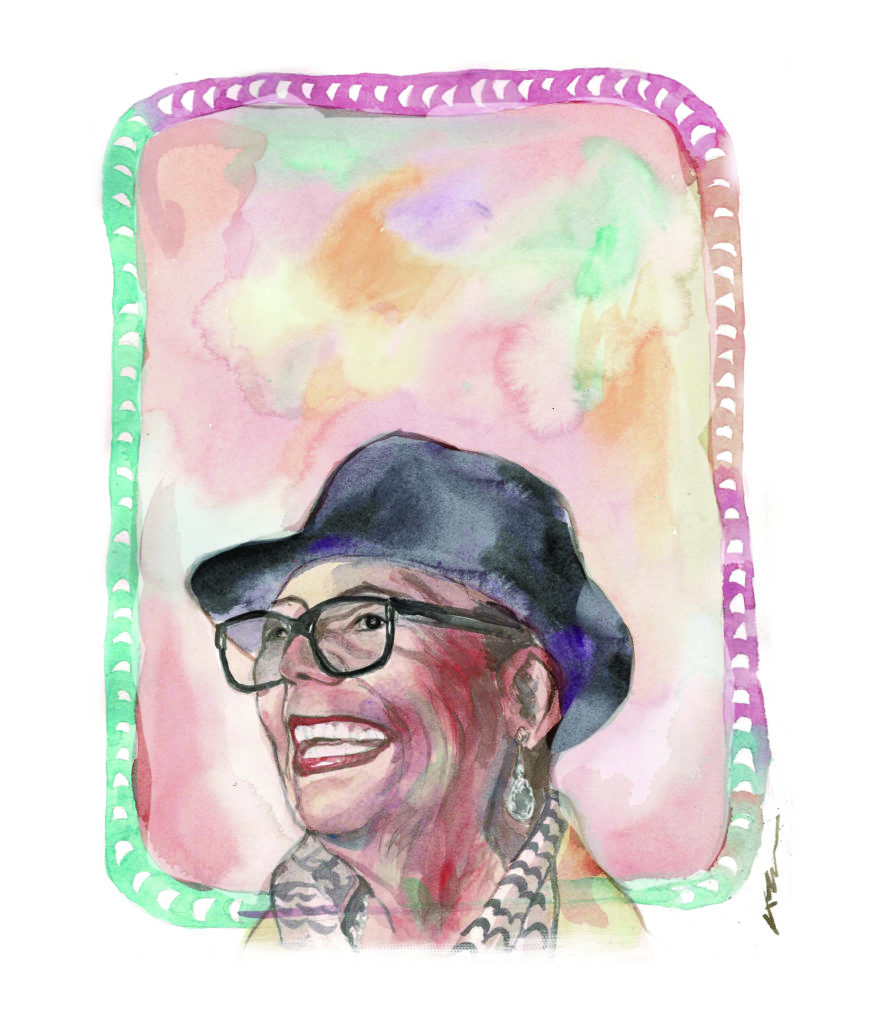Karen Lewis Struck a Blow for Justice
Illustrator: Keith Henry Brown

When Karen Lewis, the past president of the Chicago Teachers Union, succumbed to a long battle with brain cancer on Feb. 8, 2021, we lost one of the greatest freedom fighters of our time. And I lost a dear friend and mentor.
Karen was born in 1953 on the South Side of Chicago into a family of educators. She attended the city’s public schools and became one of the first Black women to graduate from Dartmouth College. Karen’s Jewish faith was important to her and she was a Renaissance woman who was a pianist, a thespian, a comedian, and could speak three languages.
Karen served as a high school chemistry teacher for more than 20 years before she became a teacher to the entire nation about the power of combining social justice unionism, solidarity, and love to defeat neoliberal policymakers whose corporate perspectives imperil public education. As current Chicago Teachers Union president Jesse Sharkey explained, Karen “taught us to see our own power and believed in the purpose of public education and the justice in it.” And she also taught us how to laugh while in the struggle — and I mean laugh really hard, often at the absurdity of the politicians and billionaires who thought they knew more than educators about how to run the schools.
Yet her infectious smile and laugh weren’t just innocent or carefree. Her humor was often cutting, the sharpest tool in her organizing chest. I will never forget sharing an uproarious chuckle with her in her office as she witheringly described then-Mayor Rahm Emanuel, whom she called the “murder mayor” for his attacks on the city’s working class. Karen blasted his hypocrisy for insisting on high-stakes tests for our children as he sent his own kids to an elite private school that doesn’t require teachers to spend hours a week drilling kids to pass mind-numbing standardized tests and doesn’t evaluate teachers by how well their students do on those assessments. Even thinking about that moment now brings a smile to my face that isn’t simply a lighthearted grin, but one that invokes a sense of my own self-worth and the confidence to challenge inequities that Karen made me feel whenever I was around her.
Karen Lewis’ trajectory to become one of the greatest labor leaders of my lifetime — leading one of the most consequential strikes of our era — started, as revolutions sometimes do, at a study group with only a few comrades. When Mayor Richard Daley of Chicago announced a plan to privatize education by closing scores of schools and then opening charters (a plan with the Orwellian name “Renaissance 2020”), Karen joined the Caucus of Rank-and-File Educators (CORE) and led a study group on Naomi Klein’s book The Shock Doctrine. Klein’s analysis of how neoliberal reformers exploit crises in society to enact profit-driven privatization helped explain dangerous policies proposed for Chicago’s public schools. With that knowledge, CORE began organizing colleagues and communities to resist the closures of some 16 schools, turning out hundreds of parents to picket Chicago Board of Education meetings and to testify in defense of their schools. As a result of this bold campaign and other organizing initiatives, teachers from the CORE slate were elected to leadership positions in the Chicago Teachers Union in the spring of 2010. Karen Lewis, the newly elected president of the CTU, remarked at her acceptance speech:
Today marks the beginning of the end of scapegoating educators for all the social ills that our children, families, and schools struggle against every day. Today marks the beginning of a fight for true transparency in our educational policy — how to accurately measure learning and teaching, how to truly improve our schools, and how to evaluate the wisdom behind our spending priorities. This election shows the unity of 30,000 educators standing strong to put business in its place — out of our schools. Corporate America sees K–12 public education as $380 billion that, up until the last 10 or 15 years, they didn’t have a sizable piece of. . . . Our teachers and paraprofessionals are poised to reclaim the power of our 30,000 members and protect what we love: teaching and learning in publicly funded public schools.
She quickly had occasion to back up her tough talk with bold action.
In the spring of 2012, Emanuel and his appointed Board of Education, composed of millionaires and billionaires, began contract negotiations with a plan that echoed long-standing and disastrous efforts to impose business models on Chicago’s schools. They proposed extending the school year without increasing pay for teachers; class sizes that could reach 55 students; and a merit pay scheme for teachers that would have narrowed the curriculum to drill-and-kill test prep (even though a 2010 pilot program had shown no impact on student learning).
With more than 90 percent of educators voting in favor, the CTU began its first strike in a quarter of a century on Sept. 10, 2012. They held the line for more than a week in a strike that captured the imagination of workers around the country and headlines around the world with their pledge to fight for “the schools our children deserve” and their insistence that “teachers’ working conditions are students’ learning conditions.” Kirstin Roberts, a CTU preschool teacher, wrote, “The outpouring of solidarity was matched by an outpouring of creativity on the picket lines and at the mass protests every afternoon. Teachers and staff who had long been stifled and forced to deliver rote lessons designed solely for test preparation began to paint and dance and sing their struggle.”
The strike was a success, with the CTU beating back the worst proposals from the city and winning the hiring of 600 additional teachers in art, music, and physical education; racial diversity hiring initiatives to reverse the loss of African American teachers in Chicago’s schools; a funding pool for social workers, psychologists, special education teachers, classroom assistants, and counselors in schools with high caseloads; $250 annual reimbursement for teachers buying classroom supplies; and a 7 percent rise in pay over three years, maintaining “steps and lanes,” so experienced teachers and those with master’s degrees earn more.
In large measure, the CTU won because it transformed a labor dispute into a social movement. Educators fused their struggle with that of the community they serve — organizing with parents for more than a year prior to the strike, making demands for increased resources for the students, and advocating for racial equity in hiring. They united with the Occupy Chicago movement by insisting that the needs of students and their families could only be met by policies beyond the schools that addressed the root causes of social and economic inequality. By striking not only for better wages, but also to defend and enrich public education for Black and Brown and low-income families, the CTU’s strike garnered 66 percent support from the students’ parents and caregivers and earned the citywide solidarity teachers would need to give them enough courage to walk off the job.
Karen was always at the heart of collective struggle that transformed the CTU. As CORE member and CTU leader Jackson Potter eulogized, “It was her life force that helped launch the zeitgeist of a new militant teachers’ movement that has not stopped growing since she helped spark it.”
And Karen and the CTU’s spark certainly has lit a prairie fire that has influenced countless educators in more ways than we will ever know.
It was CORE and Karen Lewis’ example that inspired me to help co-found the Social Equity Educators in Seattle — the rank-and-file union caucus that helped launch the Black Lives Matter at School movement, and propelled the successful 2013 educator boycott of the Measures of Academic Progress (MAP) test, which resulted in the elimination of the exam for Seattle’s high schools. Karen’s support for the MAP test boycott was vital in helping Seattle teachers gain the solidarity from around the country they needed to win that struggle. Her valuable counsel to me about how to best support the educators at Garfield High School, where I teach, and at the six other schools that joined the testing boycott, were vital to our success. It’s hard to imagine the 2018–2019 “red state revolt” of teacher strikes in Republican-controlled states or the subsequent strikes in Los Angeles, Denver, Oakland, and around Washington state without the powerful example of the Chicago Teachers Union.
One of the founders of Chicago educator unionism back in the late 1890s was schoolteacher Margaret Haley, dubbed the “Lady Labor Slugger.” Haley was the seminal figure in a class struggle approach to teacher unionism and an early leader of the Chicago Teachers Federation (CTF), a precursor to the Chicago Teachers Union. Karen was our new Labor Slugger, and whenever the rich and powerful tried to bully Chicago’s schoolchildren, our Slugger stood in front of the students and would take any blow for them — before organizing an army of educators to knock the rich back in their place.
Wherever educators strike and organize, Karen Lewis is by their side.

